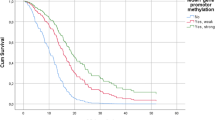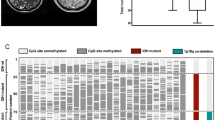Abstract
Background
MGMT promoter methylation has been associated with favorable prognosis and survival outcomes in patients with glioblastoma and WHO grade III glioma. However, the effects of promoter methylation of MGMT in patients with WHO grade II gliomas have not been established. The purpose of the current study is to evaluate the prognostic impact and predictive values of MGMT methylation in patients with grade II glioma.
Methods
The National Cancer Database (NCDB) was queried (2004–2016) for patients with newly diagnosed grade II glioma. Demographics and clinical characteristics of these patients were examined. Statistics included Kaplan–Meier overall survival (OS) analysis alongside Cox proportional hazards modeling.
Results
A total of 11,223 patients met the selection criteria; 1252 patients (11%) had MGMT testing. Of the patients who had MGMT testing, 58.5% were MGMT methylated (mMGMT), and 43.5% were MGMT unmethylated (uMGMT). mMGMT patients had greater median overall survival (77.3 months) than both uMGMT patients (42.6 months) and patients with no MGMT status reported (61.9 months (p < 0.001 for both). mMGMT was also associated with improved OS, when compared to patients with uMGMT, for patients receiving adjuvant chemoradiation or adjuvant radiation therapy.
Conclusions
This is the largest study to date demonstrating both the prognostic and predictive impact of MGMT methylation on patients with grade II glioma. The current results show that mMGMT is a prognostic factor and possibly a predictive biomarker for grade II glioma patients. MGMT methylation status can be used to determine and stratify patients by risk levels, and thus select patients for treatment intensification.
Importance of study
The present study is the largest to date examining the prognostic and predictive significance of MGMT methylation (mMGMT) in patients with WHO grade II glioma. The results suggest that mMGMT is prognostic with increasing overall survival rates for patients with mMGMT compared to uMGMT patients. The results also suggest that mMGMT is predictive as shown by improved overall survival in patients receiving gross total resection, adjuvant chemoradiation or adjuvant radiation therapy, but no difference was observed in patients receiving adjuvant chemotherapy or no adjuvant treatment.



Similar content being viewed by others
Data availability
The datasets generated during and/or analysed during the current study are not publicly available due to this being the property of the National Cancer Data Base. These data are available from the Committee On Cancer’s National Cancer Data Base on reasonable request.
References
Kros JM (2011) Grading of gliomas: the road from eminence to evidence. J Neuropathol Exp Neurol 70:101–109
Kleihues P, Burger PC, Plate KH, Ohgaki H, Cavenee WK (1997) Pathology and genetics of tumours of the nerouvs systemi. International Agency for Research on Cancer, Lyon
Shaw EG, Wang M, Coons SW et al (2012) Randomized trial of radiation therapy plus procarbazine, lomustine, and vincristine chemotherapy for supratentorial adult low-grade glioma: initial results of RTOG 9802. J Clin Oncol 30:3065–3070
Fisher BJHC, Hu C, Macdonald DR et al (2015) Phase II study of temozolomide-based chemoradiation therapy for high-risk low-grade gliomas: preliminary results of Radiation Therapy Oncology Group 0424. Int J Radiat Oncol Biol Phys 91(3):497–504
Buckner JC, Shaw EG, Pugh SL et al (2016) Radiation plus Procarbazine, CCNU, and Vincristine in low-grade glioma. New Engl J Med 374:1344–1355
National Comprehensive Cancer Network. Central Nervous System Cancers (Version 2.2021). https://www.nccn.org/professionals/physician_gls/pdf/cns.Pdf. Accessed 1 Oct 2021
Louis DN, Perry A, Reifenberger G et al (2016) The 2016 World Health Organization classification of tumors of the central nervous system: a summary. Acta Neuropathol 131(6):803–820
Louis DN, Perry A, Wesseling P et al (2021) The 2021 WHO classification of tumors of the central nervous system: a summary. Neuro Oncol 23:1231–1251
Reis GF, Pekmezci M, Hansen HM et al (2015) CDKN2A loss is associated with shortened overall survival in lower grade (World Health Organization II-III) Astrocytomas. J Neuropathol Exp Neurol 74:442–452
Stichel D, Ebrahimi A, Reuss D et al (2018) Distribution of EGFR amplification, combined chromose 7 gain and chromosome 10 loss, and TERT promoter mutation in brain tumors and their potential for the reclassification of IDHwt astrocytoma to glioblastoma. Acta Neuropathol 136:793–803
Hegi ME, Diserens A-C, Gorlia T et al (2005) MGMT gene silencing and benefit from temozolomide in glioblastoma. N Engl J Med 352(10):997–1003
Stupp R, Mason WP, van den Bent MJ et al (2005) Radiotherapy plus concomitant and adjuvant Temozlomide for Glioblastoma. New Engl J Med 352:987–996
Gilbert MR, Wang M, Aldape KD et al (2013) Dose-dense temozolomide for newly diagnosed glioblastoma: a randomized phase III clinical trial. J Clin Oncol 31(32):4085–4091
Gilbert MR, Dignam JJ, Armstrong TS et al (2014) A randomized trial of bevacizumab for newly diagnosed glioblastoma. N Engl J Med 370(8):699–708
Stupp R, Taillibert S, Kanner A et al (2017) Effect of tumor-treating fields plus maintenance temozolomide vs maintenance temozolomide alone on survival in patients with glioblastoma: a randomized clinical trial. JAMA 318(23):2306
Zhao H, Wang S, Song C, Zha Y, Li Li (2016) The prognostic value of MGMT promoter status by pyrosequencing assay for glioblastoma patients’ survival: a metaanalysis. World J Surg Oncol. https://doi.org/10.1186/s12957-016-1012-4
Haque W, Thong E, Andrabi S, Verma V, Butler EB, Teh BS (2021) Prognositc and predictive impact of MGMT promoter methylation in grade 3 gliomas. J Clin Neurosci 85:115–121
Van den bent MJ, Gravendeel LA, Gorlia T et al (2011) A hypermethylated phenotype is a better predictor of survival than MGMT methylation in anaplastic oligodendroglial brain tumors: a report from EORT study 26951. Clin Cancer Res 17:7148–7155
Van gen bent MJ, Dubbink HJ, Sanson M (2009) MGMT promoter methylation is prognostic but not predictive for outcome to adjuvant PCV chemotherapy in anaplastic oligodendroglial tumors: a report from EORTC Brain Tumor Group Study 26951. J Clin Oncol 27(35):5881–5886
Van den Bent MJ, Baumert B, Erridge SC et al (2017) Interim results from the CATNON trial (EORTC study 26053–22054) of treatment with concurrent and adjuvant temozolomide for 1p/19q non-co-deleted anaplastic glioma: a phase 3, randomised, open-label intergroup study. The Lancet 390(10103):1645–1653
Bell EH, Zhang P, Fisher BJ, Macdonald DR, McElroy JP, Lesser GJ et al (2018) Association of MGMT promoter methylation status with survival outcomes in patients with high-risk glioma treated with radiotherapy and temozolomide: an analysis from the NRG Oncology/RTOG 0424 Trial. JAMA Oncol 4(10):1405–1409
Biilimoria KY, Stewart AK, Winchester DP et al (2008) The National Cancer Data Base: a powerful initiative to improve cancer care in the United States. Ann Surg Oncol 15(3):683–690
Ladha KS, Zhao K, Quraishi SA et al (2015) The Deyo-Charlson and Elixhauser-van Walraven comorbidity predictors of mortality in critically ill patients. BMJ Open 5:e008990
Sechidis K, Papangelou K, Metcalfe PD et al (2018) Distinguishing prognostic and predicitive biomarkers: an information theoretic approach. Bioinformatic 34:3365–3376
Malmstrom A, Gronberg BH, Marosi C et al (2012) Temozolomide versus standard 6-week radiotherapy versus hypofractionated radiotherapy in patients older than 60 years with glioblastoma: the Nordic randomised, phase 3 trial. Lancet Oncol 13:916–926
Wick W, Platten M, Meisner C et al (2012) Temozolomide chemotherapy versus radiotherapy alone for malignant astrocytoma in the elderly: the NOA-08 randomised, phase 3 trial. Lancet Oncol 13:707–715
Xia L, Fang C, Chen G, Sun C (2018) Relationship between the extent of resection and the survival of patients with low-grade gliomas: a systematic review and meta-analysis. BCM Cancer 18:48
Funding
There was no research support for this study.
Author information
Authors and Affiliations
Contributions
WH: Experimental design, analysis and interpretation of data, writing and revising manuscript. CT: analysis and interpretation of data, writing and revising manuscript. EBB: analysis and interpretation of data, writing and revising manuscript. BST: analysis and interpretation of data, writing and revising manuscript.
Corresponding author
Ethics declarations
Conflict of interest
The authors have no conflicts of interest.
Ethical approval
As all patient information in the NCDB database is de-identified, this study was exempt from institutional review board evaluation.
Additional information
Publisher's Note
Springer Nature remains neutral with regard to jurisdictional claims in published maps and institutional affiliations.
Rights and permissions
About this article
Cite this article
Haque, W., Teh, C., Butler, E.B. et al. Prognostic and predictive impact of MGMT promoter methylation status in high risk grade II glioma. J Neurooncol 157, 137–146 (2022). https://doi.org/10.1007/s11060-022-03955-3
Received:
Accepted:
Published:
Issue Date:
DOI: https://doi.org/10.1007/s11060-022-03955-3




